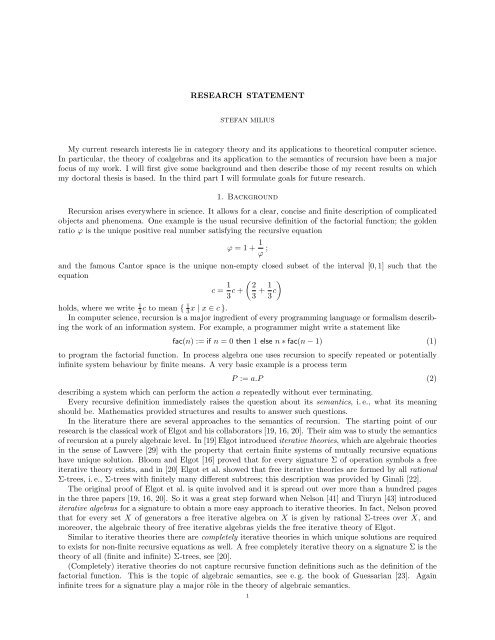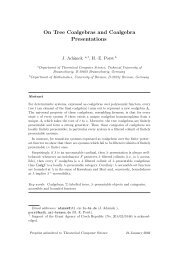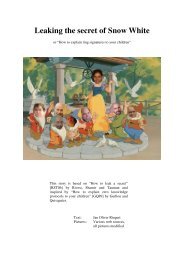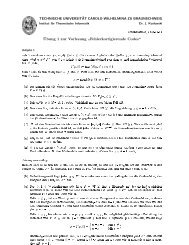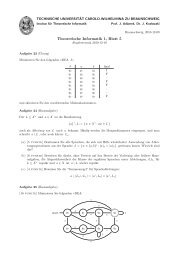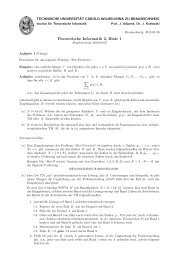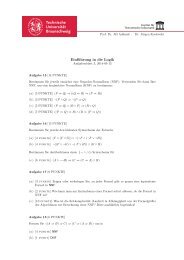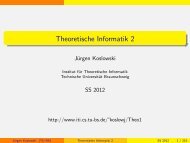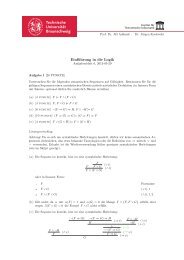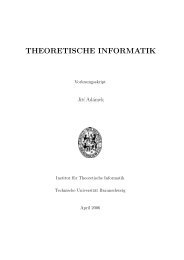RESEARCH STATEMENT My current research interests lie in ...
RESEARCH STATEMENT My current research interests lie in ...
RESEARCH STATEMENT My current research interests lie in ...
Create successful ePaper yourself
Turn your PDF publications into a flip-book with our unique Google optimized e-Paper software.
<strong>RESEARCH</strong> <strong>STATEMENT</strong>STEFAN MILIUS<strong>My</strong> <strong>current</strong> <strong>research</strong> <strong><strong>in</strong>terests</strong> <strong>lie</strong> <strong>in</strong> category theory and its applications to theoretical computer science.In particular, the theory of coalgebras and its application to the semantics of recursion have been a majorfocus of my work. I will first give some background and then describe those of my recent results on whichmy doctoral thesis is based. In the third part I will formulate goals for future <strong>research</strong>.1. BackgroundRecursion arises everywhere <strong>in</strong> science. It allows for a clear, concise and f<strong>in</strong>ite description of complicatedobjects and phenomena. One example is the usual recursive def<strong>in</strong>ition of the factorial function; the goldenratio ϕ is the unique positive real number satisfy<strong>in</strong>g the recursive equationϕ = 1 + 1 ϕ ;and the famous Cantor space is the unique non-empty closed subset of the <strong>in</strong>terval [0, 1] such that theequationc = 1 3 c + ( 23 + 1 3 c )holds, where we write 1 3 c to mean { 1 3 x | x ∈ c }.In computer science, recursion is a major <strong>in</strong>gredient of every programm<strong>in</strong>g language or formalism describ<strong>in</strong>gthe work of an <strong>in</strong>formation system. For example, a programmer might write a statement likefac(n) := if n = 0 then 1 else n ∗ fac(n − 1) (1)to program the factorial function. In process algebra one uses recursion to specify repeated or potentially<strong>in</strong>f<strong>in</strong>ite system behaviour by f<strong>in</strong>ite means. A very basic example is a process termP := a.P (2)describ<strong>in</strong>g a system which can perform the action a repeatedly without ever term<strong>in</strong>at<strong>in</strong>g.Every recursive def<strong>in</strong>ition immediately raises the question about its semantics, i. e., what its mean<strong>in</strong>gshould be. Mathematics provided structures and results to answer such questions.In the literature there are several approaches to the semantics of recursion. The start<strong>in</strong>g po<strong>in</strong>t of our<strong>research</strong> is the classical work of Elgot and his collaborators [19, 16, 20]. Their aim was to study the semanticsof recursion at a purely algebraic level. In [19] Elgot <strong>in</strong>troduced iterative theories, which are algebraic theories<strong>in</strong> the sense of Lawvere [29] with the property that certa<strong>in</strong> f<strong>in</strong>ite systems of mutually recursive equationshave unique solution. Bloom and Elgot [16] proved that for every signature Σ of operation symbols a freeiterative theory exists, and <strong>in</strong> [20] Elgot et al. showed that free iterative theories are formed by all rationalΣ-trees, i. e., Σ-trees with f<strong>in</strong>itely many different subtrees; this description was provided by G<strong>in</strong>ali [22].The orig<strong>in</strong>al proof of Elgot et al. is quite <strong>in</strong>volved and it is spread out over more than a hundred pages<strong>in</strong> the three papers [19, 16, 20]. So it was a great step forward when Nelson [41] and Tiuryn [43] <strong>in</strong>troducediterative algebras for a signature to obta<strong>in</strong> a more easy approach to iterative theories. In fact, Nelson provedthat for every set X of generators a free iterative algebra on X is given by rational Σ-trees over X, andmoreover, the algebraic theory of free iterative algebras yields the free iterative theory of Elgot.Similar to iterative theories there are completely iterative theories <strong>in</strong> which unique solutions are requiredto exists for non-f<strong>in</strong>ite recursive equations as well. A free completely iterative theory on a signature Σ is thetheory of all (f<strong>in</strong>ite and <strong>in</strong>f<strong>in</strong>ite) Σ-trees, see [20].(Completely) iterative theories do not capture recursive function def<strong>in</strong>itions such as the def<strong>in</strong>ition of thefactorial function. This is the topic of algebraic semantics, see e. g. the book of Guessarian [23]. Aga<strong>in</strong><strong>in</strong>f<strong>in</strong>ite trees for a signature play a major rôle <strong>in</strong> the theory of algebraic semantics.1
2 STEFAN MILIUS2. Recent Research2.1. Completely Iterative Algebras. <strong>My</strong> paper [34] concerns a generalization and extension of the classicalwork of Elgot and Nelson us<strong>in</strong>g ideas from the theory of coalgebras, see e. g. [2, 24, 27, 42] for <strong>in</strong>troductorytexts. The basic observation is that <strong>in</strong>f<strong>in</strong>ite Σ-trees form the term<strong>in</strong>al coalgebra for the polynomial endofunctorassociated to the signature Σ. Then one can prove the classical results us<strong>in</strong>g category-theoreticmethods, i. e., the universal property of a term<strong>in</strong>al coalgebra is sufficient to obta<strong>in</strong> those result.More precisely, <strong>in</strong> <strong>lie</strong>u of a signature one works with an endofunctor H of Set (or a more general categorysatisfy<strong>in</strong>g some rather mild side conditions). Then a (co-)algebra is an underly<strong>in</strong>g set A together with a mapfrom HA to A (or from A to HA, respectively). I <strong>in</strong>troduce the concept of completely iterative algebras(cia). For a signature Σ the algebra T Σ X of all Σ-trees over the set X of generators is completely iterative.Other important examples stem from the realm of algebras on complete metric spaces. We already saw thegolden ratio and the Cantor space as unique solutions of recursive equations. The respective cias are carriedby the <strong>in</strong>terval [1, 2] and by the set of non-empty closed subsets of [0, 1] with the Hausdorff metric. A basicopen<strong>in</strong>g result of the theory of cias is theTheorem 2.1. [34] A free cia on a set X is precisely a term<strong>in</strong>al coalgebra for the functor H( ) + X.The importance of this result, br<strong>in</strong>g<strong>in</strong>g algebraic and coalgebraic methods under one roof, <strong>lie</strong>s <strong>in</strong> applications:term<strong>in</strong>al coalgebras often serve as doma<strong>in</strong>s for semantics of recursive def<strong>in</strong>ition; <strong>in</strong>f<strong>in</strong>ite trees, streams,formal languages accepted by sequential automata form term<strong>in</strong>al coalgebras. The characterization of term<strong>in</strong>alcoalgebras as free algebras of some sort opens the door for coalgebraic tools <strong>in</strong> algebraic semantics.And so we work with endofunctors that have enough term<strong>in</strong>al coalgebras, i. e., for every set X there exists aterm<strong>in</strong>al coalgebra T X for H( ) + X. This is a mild assumption. For example, every accessible endofunctorof Makkai and Paré [30] has enough term<strong>in</strong>al coalgebras.Theorem 2.2. [1, 34] Let H have enough term<strong>in</strong>al coalgebras T X. Then T is the object assignment of amonad, and this monad is the free completely iterative monad on H.This result is an analogue of Nelson’s result on iterative algebras; the above theorem states that free ciasyield a free completely iterative theory. At the same time our result is more general and we feel that ourproof is clearer us<strong>in</strong>g category-theoretic language and tools. For the category-theoretic semantics of recursivefunction def<strong>in</strong>itions Theorem 2.2 is an important prerequisite. In the special case of a polynomial endofunctoraris<strong>in</strong>g from a signature, the universal property of the monad T captures second-order substitution, i. e.,substitution of <strong>in</strong>f<strong>in</strong>ite trees for operation symbols. This notion is necessary to formulate the notion of asolution of a recursive function def<strong>in</strong>ition <strong>in</strong> the appropriate generality. We be<strong>lie</strong>ve that this is the first timesecond-order substitution is understood by a categorical universal property.2.2. Iterative Algebras. In jo<strong>in</strong>t work with Adámek and Velebil [4, 5, 6] we deal with iterative algebrasand iterative theories. Recall that here we are concerned with unique solutions of f<strong>in</strong>ite systems of recursiveequations. Hence, the suitable category-theoretic environment for this study are locally f<strong>in</strong>itely presentablecategories of Gabriel and Ulmer [21], e. g., sets, posets, graphs, f<strong>in</strong>itary varieties of algebras, etc. In this sett<strong>in</strong>gwe <strong>in</strong>troduce iterative algebras for an endofunctor. All completely iterative algebras for an endofunctorare, of course, iterative. Rational trees for a signature Σ form an iterative algebra which is not completelyiterative (for the polynomial endofunctor aris<strong>in</strong>g from Σ).Theorem 2.3. [6] For a f<strong>in</strong>itary endofunctor H a free iterative algebra RX on an object X is obta<strong>in</strong>ed asthe colimit of all coalgebras for H( ) + X with a f<strong>in</strong>itely presentable carrier.The existence of free iterative algebras is easy to prove from general category-theoretic results. However,the coalgebraic construction is a non-trivial and crucial result. All our subsequent results on iterativity relyon it. Furthermore, it yields explicit descriptions of free iterative algebras. For example, the constructionexpla<strong>in</strong>s that for a signature Σ free iterative algebras are rational Σ-trees as expected. The ma<strong>in</strong> resultof [4, 6] isTheorem 2.4. For every f<strong>in</strong>itary endofunctor of a locally f<strong>in</strong>itely presentable category the monad of freeiterative algebras is a free iterative monad.
<strong>RESEARCH</strong> <strong>STATEMENT</strong> 3Aga<strong>in</strong>, <strong>in</strong> the special case of a polynomial endofunctor of Set aris<strong>in</strong>g from a signature the above Theoremyields Nelson’s classical result. Our proof is much shorter then Elgot’s orig<strong>in</strong>al proof and, moreover, and isconceptually much clearer than any of the previous proofs.2.3. Elgot Algebras. In another jo<strong>in</strong>t paper [7] with Adámek and Velebil we characterize the Eilenberg-Moore algebras of the free iterative monads and of the free completely iterative monads. For an endofunctorof a category with f<strong>in</strong>ite coproducts we <strong>in</strong>troduce complete Elgot algebras: they are algebras for the functortogether with a (non-unique) choice of solutions of every recursive equation system of a certa<strong>in</strong> very simpleform. This choice of solutions has to satisfy two simple and well-motivated axioms.Theorem 2.5. Let H be an endofunctor with enough term<strong>in</strong>al coalgebras. Then the category of completeElgot algebras is isomorphic to the category of Eilenberg-Moore algebras for the free completely iterativemonad on H.Similarly, we <strong>in</strong>troduce (non-complete) Elgot algebras; they come with a choice of solutions of f<strong>in</strong>itarysystems of equations. The choice of solutions is required to satisfy the same two axioms.Theorem 2.6. Let H be a f<strong>in</strong>itary endofunctor of a locally f<strong>in</strong>itely presentable category. Then the categoryof Elgot algebras for H is isomorphic to the category of Eilenberg-Moore algebras for the free iterative monadon H.These two results are an important tool <strong>in</strong> applications. It turns out that algebras used <strong>in</strong> classical algebraicapproaches to the semantics of recursion are complete Elgot algebras. For example, cont<strong>in</strong>uous algebrasfor a signature, which are carried by a complete partial order and where operations are cont<strong>in</strong>uous maps,are complete Elgot algebras. And so are algebras on complete metric spaces with contract<strong>in</strong>g operations.In fact, all (completely) iterative algebras are (complete) Elgot algebras. So on the one hand, the notionof (complete) Elgot algebra builds a common roof over various notions of algebras used <strong>in</strong> semantics. Onthe other hand, complete Elgot algebras have enough structure to provide semantics of recursive functiondef<strong>in</strong>itions. This is the topic of the next section.2.4. Recursive Program Schemes. In the jo<strong>in</strong>t paper [38] with Moss we turn more to applications of ourmathematical results <strong>in</strong> semantics. We have started to rework the classical theory of algebraic semantics,see e. g. [23], us<strong>in</strong>g our category-theoretic mach<strong>in</strong>ery. In <strong>lie</strong>u of sets, signatures and <strong>in</strong>f<strong>in</strong>ite trees we workwith abstract categories and endofunctors hav<strong>in</strong>g enough term<strong>in</strong>al coalgebras. In this sett<strong>in</strong>g we show howto formulate recursive program schemes and their un<strong>in</strong>terpreted and <strong>in</strong>terpreted solutions. Our results ma<strong>in</strong>results state for every guarded 1 recursive program scheme:(a) A unique un<strong>in</strong>terpreted solution exists.(b) In every complete Elgot algebra there exists a canonical <strong>in</strong>terpreted solution.(c) In every completely iterative algebra a unique <strong>in</strong>terpreted solution exists.(d) The un<strong>in</strong>terpreted solution of (a) and the <strong>in</strong>terpreted ones of (b) and (c) are consistent.These results generalize all previous work on the topic. Moreover, we can provide semantics of recursivefunction def<strong>in</strong>itions which are not captured by the classical theory. For example, recursive program schemesdef<strong>in</strong><strong>in</strong>g operations satisfy<strong>in</strong>g equations, e. g. commutativity. From our results on <strong>in</strong>terpreted schemes onecan recover the usual denotational semantics us<strong>in</strong>g cont<strong>in</strong>uous algebras. Work<strong>in</strong>g with algebras on completemetric spaces yields new applications which had so far not been recognized as solutions of recursive programschemes, e. g., fractals like the Cantor space. These applications show that we have obta<strong>in</strong>ed a unified viewof solutions pr<strong>in</strong>ciples for a large class of recursive def<strong>in</strong>itions <strong>in</strong>clud<strong>in</strong>g the usual algebraic semantics ofrecursive program schemes. Of course, our more abstract theory takes some effort to build. But we feel thatthe ga<strong>in</strong> <strong>in</strong> conceptual clarity more than outweighs this effort. Our work unveils the basic mechanisms atwork <strong>in</strong> the semantics of recursion.3. Future ResearchThere are several topics that I consider very fruitful for future <strong>research</strong>. Some of them have already beenpartially attended to by our <strong>research</strong> group.1 Guardedness is an easy syntactic condition of a recursive program scheme <strong>in</strong>spired by a similar condition <strong>in</strong> the classicalwork called Greibach normal form.
4 STEFAN MILIUS3.1. Iterative Algebras for a Base. One l<strong>in</strong>e of our present <strong>research</strong> has been <strong>in</strong>spired by the workof Uustalu [44]. He proposed to study complete iterativity with respect to a so-called base <strong>in</strong> <strong>lie</strong>u of anendofunctor. A base is a functor from the category A to the category of (f<strong>in</strong>itary) monads on A. Bases allowan <strong>in</strong>terest<strong>in</strong>g extension of our theory which captures algebras satisfy<strong>in</strong>g certa<strong>in</strong> equations and where theiterativity can be restricted. In fact, we have taken up the task to extend the results on iterative algebrasand iterative monads of [4, 6] to bases with the series of papers [8, 9, 10, 11, 12] most of which are still <strong>in</strong>preparation.Research Problem 3.1. Investigate completely iterative algebras for a base and extend our results of [1, 34]to this sett<strong>in</strong>g.3.2. Algebraic Trees. An important application of the theory of iterativity for a base is presented <strong>in</strong> [13]:a category theoretic description of the monad of algebraic trees. Classically, algebraic trees over a signatureΣ are those trees aris<strong>in</strong>g as the un<strong>in</strong>terpreted solutions of all recursive program schemes with the givens fromΣ, see [18]. We have shown how to obta<strong>in</strong> the monad of algebraic trees from the free iterative monad for abase on the category of f<strong>in</strong>itary endofunctors of Set.Research Problem 3.2.(i) Formulate and establish the follow<strong>in</strong>g properties of algebraic trees <strong>in</strong> the category-theoretic sett<strong>in</strong>g:(a) algebraic trees form an iterative theory;(b) algebraic trees are closed under second-order substitution;(c) algebraic trees are rational trees over a signature with additional explicit substitution operations.(ii) F<strong>in</strong>d a universal property that characterizes the monad of algebraic trees up to isomorphism.In contrast to all Σ-trees and all rational Σ-trees, respectively, a universal property is not known foralgebraic trees <strong>in</strong> the classical sett<strong>in</strong>g. So it would be a great success of the category-theoretic approach toprovide such a result.3.3. Iterative Reflection of a Monad. Our previous work shows how to obta<strong>in</strong> a free iterative monad ona f<strong>in</strong>itary endofunctor of a locally f<strong>in</strong>itely presentable category. How about start<strong>in</strong>g with a f<strong>in</strong>itary monad?Research Problem 3.3. Does there exist an iterative reflection of a given f<strong>in</strong>itary monad of a locally f<strong>in</strong>itelypresentable category?This would yield another important new result <strong>in</strong> the classical sett<strong>in</strong>g; an iterative theory free on (thetheory given by) a signature and a f<strong>in</strong>ite set of equations <strong>in</strong>volv<strong>in</strong>g operation symbols of that signature.I have a partial result [36] show<strong>in</strong>g that every ideal f<strong>in</strong>itary monad of Set has an iterative reflection. Theconcept of an ideal theory was <strong>in</strong>troduced by Elgot <strong>in</strong> order to study iterativity, see [19]. Ideal monads forma subcategory of all f<strong>in</strong>itary monads of Set. Although the proof of the partial result provides a coalgebraicconstruction one does not obta<strong>in</strong> an explicit description of the iterative reflection from that. But sucha description would be highly desirable <strong>in</strong> order to obta<strong>in</strong> further examples of iterative theories and tounderstand whether the partial result can be extended beyond Set.Research Problem 3.4. Give an explicit description of an iterative reflection of an ideal f<strong>in</strong>itary monadof Set.For free iterative monads on endofunctors of Set an explicit description is provided by Adámek and myself<strong>in</strong> [3].Similar problems as above should also be addressed <strong>in</strong> the completely iterative case. Among expectedapplications of the theory developed to answer those problems are a semantics of recursive program schemesus<strong>in</strong>g operations satisfy<strong>in</strong>g equations.3.4. More on Recursive Program Schemes. Our work on solutions of recursive program schemes wasjust the beg<strong>in</strong>n<strong>in</strong>g of a long term project to rework algebraic semantics with category-theoretic methods.The next steps <strong>in</strong>clude:(a) F<strong>in</strong>d other applications. For example, work<strong>in</strong>g with the power-set functor we obta<strong>in</strong> applications<strong>in</strong> the theory of hypersets of Barwise and Moss [15]. Other possible applications <strong>lie</strong> <strong>in</strong> the realm ofprocess calculi, e. g. Milner’s CCS [39].
<strong>RESEARCH</strong> <strong>STATEMENT</strong> 5(b) Investigate higher-order recursive program schemes def<strong>in</strong><strong>in</strong>g functions on function spaces. Matthesand Uustalu [31] have addressed the extremely useful concept of variable b<strong>in</strong>d<strong>in</strong>g and this may wellbe relevant <strong>in</strong> this respect.(c) Study the equivalence of <strong>in</strong>terpreted program schemes. One of the ma<strong>in</strong> goals of the orig<strong>in</strong>al theorywas to provide foundations for the study of program equivalence. S<strong>in</strong>ce on the natural numbers theequivalence of recursive program schemes is undecidable one works with classes of <strong>in</strong>terpretations.These classes are def<strong>in</strong>ed on ordered algebras, see [23]. Do complete Elgot algebras suggest tractableclasses of <strong>in</strong>terpretations?3.5. Logical Calculi. For a variety of algebras def<strong>in</strong>ed by a signature and a f<strong>in</strong>ite set of equations there isthe calculus of equational logic, which is sound and complete.Research Problem 3.5. Investigate the equational logic of (completely) iterative algebras and (complete)Elgot algebras!Work on the formal language of recursion by Hurkens et al. [26] and on the equational logic of term<strong>in</strong>alcoalgebras for polynomial endofunctors of Set by Moss [40] are the start<strong>in</strong>g po<strong>in</strong>t <strong>in</strong> this direction.Mersch [32] has studied a sound and complete logical calculus for un<strong>in</strong>terpreted recursive program schemesw. r. t. polynomial endofunctors of Set.Research Problem 3.6. Develop a similar calculus for arbitrary endofunctors (of other base categoriesthan Set)!3.6. Relation to Other Structures. I will soon <strong>in</strong>vestigate the connection of (completely) iterative monadsto other structures typically used <strong>in</strong> semantics.Research Problems 3.7.(i) Investigate equational properties of unique solutions <strong>in</strong> iterative monads and prove that the Kleislicategory of an iterative monad is a traced monoidal category of Joyal, Street and Verity [28], seealso [25]. Does this property of the Kleisli category yield an equivalent description of iterativemonads?(ii) For a locally f<strong>in</strong>itely presentable category A the assignment of a free iterative monad to a f<strong>in</strong>itaryendofunctor yields itself a monad on the category of f<strong>in</strong>itary endofunctors of A. Characterize theEilenberg-Moore algebras of this monad!<strong>My</strong> prelim<strong>in</strong>ary work [37] <strong>in</strong>dicates that the Eilenberg-Moore algebras <strong>in</strong> (ii) are closely related to iterationtheories of Bloom and Ésik [17].In a first serious step [14] towards the solution of the above problems we have shown that <strong>in</strong> (completely)iterative theories all recursive equations can be given a canonical solution.3.7. Other Topics. The <strong>in</strong>tended future <strong>research</strong> presented so far is concentrated on results of my doctoralthesis and other recent previous work. But I would also like to follow different topics <strong>in</strong> future <strong>research</strong>.One such topic could arise by revisit<strong>in</strong>g results from my Master’s thesis [33]. There first steps <strong>in</strong>to the<strong>in</strong>vestigation of factorization systems <strong>in</strong> 2-categories were made. I hope to f<strong>in</strong>d the opportunity to comeback to that work and develop that theory further.References[1] Peter Aczel, Jiří Adámek, Stefan Milius and Jiří Velebil, Inf<strong>in</strong>ite Trees and Completely Iterative Theories: A CoalgebraicView, Theoret. Comput. Sci. 300 (2003), 1–45.[2] Jiří Adámek, Introduction the Coalgebra, Theory Appl. Categ. 14 (2005), 157–199.[3] Jiří Adámek and Stefan Milius, Term<strong>in</strong>al Coalgebras and Free Iterative Theories, accepted for publication <strong>in</strong> Inform. andComput., available via http://www.iti.cs.tu-bs.de/~milius.[4] Jiří Adámek, Stefan Milius and Jiří Velebil, Free Iterative Theories: a coalgebraic view, Math. Structures Comput. Sci. 13(2003), no. 2, 259–320.[5] Jiří Adámek, Stefan Milius and Jiří Velebil, On Rational Monads and Free Iterative Theories, Electron. Notes Theor. Comput.Sci. 69 (2002), 24 pp.[6] Jiří Adámek, Stefan Milius and Jiří Velebil, From Iterative Algebras to Iterative Theories, submitted, available viahttp://www.iti.cs.tu-bs.de/~milius, extended abstract appeared <strong>in</strong> Electron. Notes Theor. Comput. Sci. 106 (2004),3–24.
6 STEFAN MILIUS[7] Jiří Adámek, Stefan Milius and Jiří Velebil, Elgot Algebras, prepr<strong>in</strong>t (2005), available viahttp://www.iti.cs.tu-bs.de/~milius, extended abstract to appear <strong>in</strong> Electron. Notes Theor. Comput. Sci.[8] Jiří Adámek, Stefan Milius and Jiří Velebil, Algebras with Parameterized Iterativity, submitted, available viahttp://www.iti.cs.tu-bs.de/~milius.[9] Jiří Adámek, Stefan Milius and Jiří Velebil, Bases for Parameterized Iterativity, prepr<strong>in</strong>t (2005), available viahttp://www.iti.cs.tu-bs.de/~milius.[10] Jiří Adámek, Stefan Milius and Jiří Velebil, Iterative Algebras for a Base, Electron. Notes Theor. Comput. Sci. 122 (2005),147–170.[11] Jiří Adámek, Stefan Milius and Jiří Velebil, Base Modules for Parameterized Iterativity, prepr<strong>in</strong>t (2005).[12] Jiří Adámek, Stefan Milius and Jiří Velebil, Description of Bases for Parameterized Iterativity, prepr<strong>in</strong>t (2005).[13] Jiří Adámek, Stefan Milius and Jiří Velebil, Algebraic Trees Coalgebraically, manuscript (2005).[14] Jiří Adámek, Stefan Milius and Jiří Velebil, How iterative are Iterative Algebras?, submitted.[15] Jon Barwise and Lawrence S. Moss, Vicious Circles, CSLI Publications, Stanford, 1996.[16] Stephen L. Bloom and Calv<strong>in</strong> C. Elgot, The Existence and Construction of Free Iterative Theories, J. Comput. SystemSci. 12 (1974), 305–318.[17] Stephen L. Bloom and Zoltán Ésik, Iteration Theories: The equational logic of iterative processes, EATCS Monographson Theoretical Computer Science, Berl<strong>in</strong>: Spr<strong>in</strong>ger-Verlag (1993).[18] Bruno Courcelle, Fundamental properties of <strong>in</strong>f<strong>in</strong>ite trees, Theoret. Comput. Sci. 25 (1983), no. 2, 95–169.[19] Calv<strong>in</strong> C. Elgot, Monadic Computation and Iterative Algebraic Theories, <strong>in</strong>: Logic Colloquium ’73 (eds: H. E. Rose andJ. C. Shepherdson), North-Holland Publishers, Amsterdam, 1975.[20] Calv<strong>in</strong> C. Elgot, Stephen L. Bloom and Ralph T<strong>in</strong>dell, On the Algebraic Structure of Rooted Trees, J. Comput. SystemSci. 16 (1978), 361–399.[21] Peter Gabriel and Friedrich Ulmer, Lokal präsentierbare Kategorien, Lecture N. Math. 221, Spr<strong>in</strong>ger-Verlag, Berl<strong>in</strong> 1971.[22] Susanna G<strong>in</strong>ali, Regular trees and the free iterative theory, J. Comput. System Sci. 18 (1979), 228–242.[23] Irène Guessarian, Algebraic Semantics. Lecture Notes <strong>in</strong> Comput. Sci. 99, Spr<strong>in</strong>ger, 1981.[24] Hans Peter Gumm, Elements of the General Theory of Coalgebras, LUATCS’99, Rand Africaans University, Johannesburg,South Africa, 1999.[25] Masahito Hasegawa, Recursion from Cyclic Shar<strong>in</strong>g: Traced Monoidal Categories and Models of Cyclic Lambda Calculi,Proc. 3rd International Conference on Typed Lambda Calculi and Applications, Lecture Notes <strong>in</strong> Comput. Sci. 1210,196–213 Spr<strong>in</strong>ger-Verlag, Berl<strong>in</strong>, 1997.[26] A. J. C. Hurkens, Monica McArthur, Yannis N. Moschovakis, Lawrence S. Moss and Glen T. Whitney, The logic of recursiveequations, J. Symbolic Logic 63 (1998), no. 2, 451–478.[27] Bart Jacobs and Jan J. M. M. Rutten, A Tutorial on (Co)Algebras and (Co)Induction, Bull. Eur. Assoc. Theor. Comput.Sci. EATCS 62 (1997), 222–259.[28] André Joyal, Ross Street and Dom<strong>in</strong>ic Verity, Traced Monoidal Categories, Math. Proc. Cambridge Philos. Soc. 119 (1996),no. 3, 447–468.[29] F. William Lawvere, Functorial Semantics of Algebraic Theories, PhD thesis, Columbia University, 1963.[30] Michael Makkai and Robert Paré, Accessible categories: the foundation of categorical model theory, Contemp. Math. 104(1989), Amer. Math. Soc., Providence, RI.[31] Ralph Matthes and Tarmo Uustalu, Substitution <strong>in</strong> Non-Wellfounded Syntax with Variable B<strong>in</strong>d<strong>in</strong>g, Electron.Notes Theor. Comput. Sci. 82 (2003), no. 1, 15 pp.[32] Jay Mersch, Equational Logic of Recursive Program Schemes, <strong>in</strong> Proceed<strong>in</strong>gs of the 1st International Conference on Algebraand Coalgebra <strong>in</strong> Computer Science (CALCO 2005), Lecture Notes <strong>in</strong> Comput. Sci. 3629 (2005), 293–312.[33] Stefan Milius, Relations <strong>in</strong> Categories, master’s thesis, York University, 2000.[34] Stefan Milius, Completely Iterative Algebras and Completely Iterative Monads, Inform. and Comput. 196 (2005), 1–41.[35] Stefan Milius, On Iteratable Endofunctors, Electron. Notes Theor. Comput. Sci. 69 (2002), 18 pp.[36] Stefan Milius, The Iterative Reflection of an Ideal Monad, manuscript (2005).[37] Stefan Milius, Elgot monads, manuscript (2005).[38] Stefan Milius and Lawrence S. Moss, The Category Theoretic Solution of Recursive Program Schemes, extendedabstract, <strong>in</strong> Proceed<strong>in</strong>gs of the 1st International Conference on Algebra and Coalgebra <strong>in</strong> Computer Science(CALCO 2005), Lecture Notes <strong>in</strong> Comput. Sci. 3629 (2005), 293–312, full version submitted and available viahttp://www.iti.cs.tu-bs.de/~milius.[39] Rob<strong>in</strong> Milner, Communication and Concurrency, Prentice Hall, 1989.[40] Lawrence S. Moss, Recursion and corecursion have the same equational logic, Theoret. Comput. Sci. 294 (2003), 233–267.[41] Evelyn Nelson, Iterative Algebras, Theoret. Comput. Sci. 25 (1983), 67–94.[42] Jan J. M. M. Rutten, Universal coalgebra, a theory of systems, Theoret. Comput. Sci. 249 (2000), no. 1, 3–80.[43] Jerzy Tiuryn, Unique Fixed Po<strong>in</strong>ts vs. Least Fixed Po<strong>in</strong>ts, Theoret. Comput. Sci. 12 (1980), 229–254.[44] Tarmo Uustalu, Generaliz<strong>in</strong>g substitution, Theor. Inform. Appl. 37 (2003), no. 4, 315–336.


